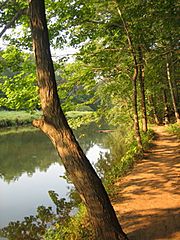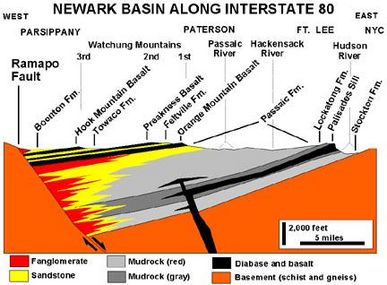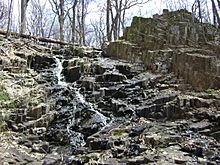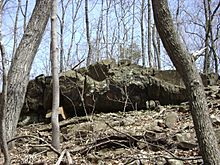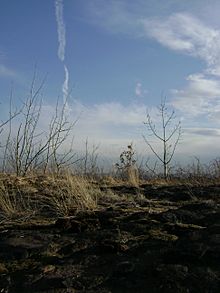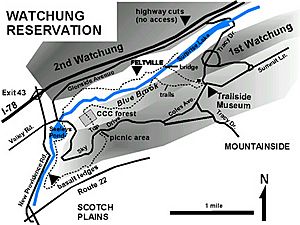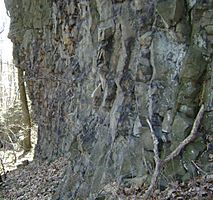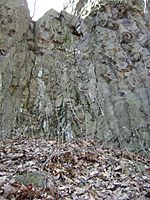Watchung Mountains facts for kids
Quick facts for kids Watchung Mountains |
|
|---|---|
| Wach Unks | |
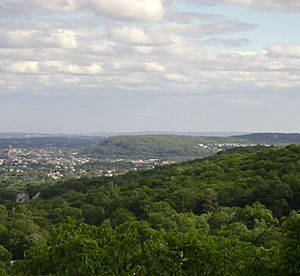
Garret Mountain and Mount Cecchino seen from High Mountain in Wayne, New Jersey
|
|
| Highest point | |
| Peak | High Mountain (Preakness Range) |
| Elevation | 879 ft (268 m) |
| Dimensions | |
| Length | 40 mi (64 km) north–south |
| Geography | |
| Country | United States of America |
| Geology | |
| Age of rock | Triassic and Jurassic |
| Type of rock | extrusive igneous and trap rock |
The Watchung Mountains are a group of three long, low hills in northern New Jersey, United States. These hills were formed by volcanoes long ago. They are about 400 to 500 feet (120 to 150 meters) high and run side-by-side.
The Watchung Mountains are famous for their amazing views of New York City, Newark, and other New Jersey cities. They also have special natural areas with rare plants, animals, and unique rocks. For a long time, these mountains helped stop cities from growing too far west. Today, many parks and historical sites are found here. They offer fun activities for people living in this busy part of the country.
Contents
Exploring the Watchung Mountains' Geography
The Watchung Mountains have two main ridges. These are called First Watchung Mountain and Second Watchung Mountain. They stretch for over 40 miles (64 km) from Somerville in the southwest to Mahwah in the northeast.
A third, less continuous ridge is sometimes called Third Watchung Mountain. It includes hills like Long Hill, Riker Hill, Hook Mountain, and Packanack Mountain. This third ridge is located to the northwest of Second Watchung Mountain.
Understanding Mountain Names
Sometimes, people mistakenly call the entire First Watchung Mountain "Orange Mountain." They also call Second Watchung Mountain "Preakness Mountain." However, "Orange" and "Preakness" are actually names for specific parts of these ridges. These names also refer to the types of rock found there. For example, the rock found at Orange Mountain is common throughout First Watchung Mountain.
Smaller Hills and Ranges
Besides the three main ridges, there's a smaller fourth ridge south of Morristown. It's about 400 feet (120 meters) above sea level. One part of this ridge is called Lees Hill.
The Watchungs are located east of the taller Appalachian Mountains. The Watchungs and the Appalachians once surrounded a huge ancient lake called Glacial Lake Passaic. Today, the Great Swamp National Wildlife Refuge is a leftover part of this old lake.
The Watchungs are also divided into smaller mountain ranges and named ridges.
Here are some of the important ones from north to south:
- Campgaw Mountain is the northernmost part. It combines First and Second Watchung Mountains.
- Preakness Mountain is part of Second Watchung Mountain. It forms the Preakness Range with Packanack Mountain. The three highest points in the Watchungs are found here.
- Goffle Hill is part of First Watchung Mountain. It's next to Preakness Mountain.
- Third Watchung Mountain starts with Packanack Mountain. It then includes Towakhow Mountain (also called Hook Mountain), Riker Hill, and Long Hill.
- The Newark Mountains is an old name for parts of First and Second Watchung Mountains. Garret Mountain and Orange Mountain are parts of First Watchung Mountain here. Caldwell Mountain and Pill Hill are parts of Second Watchung Mountain.
Some of the highest points in the Watchungs include:
- High Mountain (879 feet or 268 meters)
- Beech Mountain (869 feet or 265 meters)
- Mount Cecchino (755 feet or 230 meters)
These are all located in Wayne. Another high point is The Hilltop in Verona, which is about 675 feet (206 meters) high.
A Look Back: History of the Watchungs
The first people to live in the Watchungs were the Lenape Native Americans. They called the mountains Wach Unks, meaning ‘high hills’. We know they lived here because many old camp sites have been found. These sites are usually along rivers and in small caves. The Lenape loved the Watchungs because they had plenty of fresh water, forests, fish, and animals. They also used the high points to send smoke signals. The Lenape also grew crops in the rich soil.
When Europeans arrived, they also used the mountains' resources. They traded furs and used the rivers to power mills. Later, the powerful Great Falls of the Passaic River was used to create energy for factories. This was done by using the water falling over the side of First Watchung Mountain.
The height of the Watchungs has been useful in many ways:
- During the Revolutionary War, General George Washington used the mountains for protection. He set up his army camps in the Washington Valley between the ridges. From this high ground, he could watch British movements between Manhattan and Philadelphia. The signal points used by the Lenape were also used by Washington.
- In the 1900s, The Hilltop in Verona became home to a hospital for people with tuberculosis. The hospital was built there because the high elevation offered clean, fresh air away from the cities.
- During the Cold War, Campgaw Mountain was chosen for a Nike missile base. From 1955 to 1971, missiles here were ready to protect New York City from enemy planes. The base was closed when new types of missiles were invented.
How the Watchung Mountains Were Formed: Geology
About 200 million years ago, hot, melted rock (magma) pushed its way into the Newark Basin. This basin was a deep crack in the Earth's surface as the supercontinent Pangaea was breaking apart. The magma first stayed underground, forming large rock bodies like the Palisades Sill. But eventually, it burst out onto the surface in huge, repeated volcanic eruptions.
The Watchung Mountains were created by these eruptions. They are made of three layers of volcanic rock called flood basalts. Each time the basin filled with this basalt, it cooled into hard, blocky rock called trap rock. Then, there would be a quiet period, and dirt and sand would settle on top of the cooled lava. This created layers of basalt and other rocks in the Newark Basin.
Over millions of years, the Newark Basin tilted and folded. The western side sank deeper, making the rock layers tilt at an angle. Then, erosion started. Water and wind slowly wore away the softer rock layers. The harder basalt layers, however, were much stronger. This is why they now stand out as high ridges above the surrounding land.
Today, these basalt layers are preserved in certain areas. The largest of these areas is called the Watchung syncline. This is where most of the Watchung Mountains' basalt layers are found. The three ridges of the Watchung Mountains are the exposed, eroding edges of these strong basalt layers.
Because the Watchung Mountains are mostly made of volcanic trap rock, you can see cool features like stacked lava flows. These are easy to spot on the eastern sides of the ridges, where there are often steep cliffs. You can also see different types of lava, like blocky lava and ropey, flowing lava.
The same magma that formed the Watchungs also created Sourland Mountain and other smaller volcanic hills nearby. The Metacomet Mountains in Connecticut were also formed around the same time and in a similar way. They are like geological cousins to the Watchungs.
Minerals Found in the Watchungs
The Watchung Mountains are mainly made of volcanic basalt. This rock has been used for building roads and railroad tracks. Underneath the basalt, you can sometimes find red and white sandstone, which has been used in buildings.
Because of their volcanic past, the Watchungs are home to special minerals called zeolites. These include prehnite, analcime, and stilbite. You can find them along the exposed ridge lines. You can also find agate (especially chalcedony) and quartz crystals (sometimes amethyst) embedded in the old lava flows. Another mineral called datolite has been found near the Great Falls. Jasper and satin spar are also found in the Preakness Range.
Copper can also be found in the Watchungs. Near Belleville, copper ore was discovered, and a copper mine once operated there. Other copper-rich rocks have been found near Paterson. These usually contain red copper oxide or copper carbonate.
Protecting the Watchung Mountains: Conservation Efforts
In the mid-1900s, new highways were built through the Watchungs. This made it easier for cities to spread into the mountain valleys. Highways like I-80, I-280, and I-78 cut through the mountains. Later, I-287 circled the Watchungs, bringing more suburban growth. Many old paths through the mountains were cut off by these roads.
Today, special areas on the mountain tops, like trap rock glades, are threatened by new buildings. These glades have unique plants and animals. To protect them, people have started conservation efforts. The largest effort is the High Mountain Park Preserve. It's over 1,150 acres (4.7 square kilometers) and protects a large natural area. This park is home to rare plants, including Torrey's mountain mint, which is endangered in New Jersey.
Other large protected areas are in the valleys of the Watchungs. The Great Swamp National Wildlife Refuge is one example. It covers 7,600 acres (31 square kilometers) and has many different types of natural homes for animals. This refuge was created in 1959 by local residents who wanted to protect the land. The Great Swamp and other swampy areas are what's left of Glacial Lake Passaic. This huge lake existed during the last ice age. It drained away when a glacier melted, allowing the water to flow out through a gap in the mountains.
To help people learn more about the Watchungs, the Lenape Trail was created. This trail goes through rugged parts of the mountains and connects many historical sites in New Jersey.
Fun Things to Do: Recreation in the Watchungs
Here are some parks and natural areas in the Watchungs, from north to south:
- Campgaw Mountain Reservation (on Campgaw Mountain)
- Franklin Lakes Nature Preserve (on Goffle Hill)
- High Mountain Park Preserve (in the Preakness Range)
- Great Falls State Park (on First Watchung Mountain)
- Garret Mountain Reservation (on First Watchung Mountain)
- Rifle Camp Park (on First Watchung Mountain)
- Mills Reservation (on First Watchung Mountain)
- Hilltop Reservation (on Second Watchung Mountain)
- Eagle Rock Reservation (on First Watchung Mountain)
- Riker Hill Park (on Riker Hill)
- Lenape Trail (crosses First, Second, and Third Watchung Mountains)
- South Mountain Reservation (on First and Second Watchung Mountains)
- Watchung Reservation (on First and Second Watchung Mountains)
- Washington Rock State Park (on First Watchung Mountain)
- Washington Valley Park (on First Watchung Mountain)
- Leonard J. Buck Garden/Moggy Hollow Natural Area (on Second Watchung Mountain)
Images for kids




